

Google Analytics Set-up Checklist for Ecommerce. This article offers a step-by-step approach to setting up Google Analytics tracking for an ecommerce website.
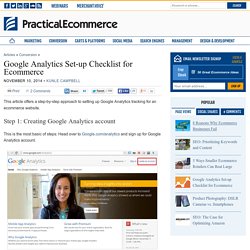
Step 1: Creating Google Analytics account This is the most basic of steps: Head over to Google.com/analytics and sign up for Google Analytics account. AOL Advertising. Linkedin.com Traffic and Demographic Statistics by Quantcast. This compares audience composition of the site or mobile app to each platform population.
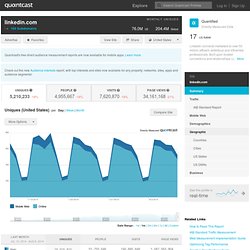
The higher the index number, the more concentrated the property is in a particular demographic. As an example, if a property indexes 100 for age 18-24, that means a given visitor to it is as likely to be 18-24 as any internet user chosen at random. An index of 200 means the visitor is twice as likely to be 18-24, 50 means half as likely, and so on. 8 Online revenue model options for Internet businesses. Selecting the best revenue options for Internet startups I’m often contacted by site owners with an idea for a new site who are trying to work out how much revenue they’ll be able to raise depending on the number of visitors to their site.
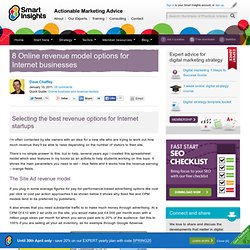
There’s no simple answer to this, but to help, several years ago I created this spreadsheet model which also features in my books as an activity to help students working on this topic. It shows the main parameters you need to set – blue fields and it works how the revenue earning – orange fields. The Site Ad revenue model If you plug in some average figures for pay-for-performance-based advertising options like cost per click or cost per action approaches li as shown below it shows why fixed fee and CPM models tend to be preferred by publishers.
It also shows that you need substantial traffic to to make much money through advertising. How to use the revenue model calculator It allows these parameters to be set: The 8 Internet revenue model options 1. 2. 3. A Framework for Social Analytics. The Social Media ROI Cookbook: How Brands Measure the Revenue Impact of Social Media. Everyone talks about the challenges of measuring the revenue impact of social media, but how are top brands actually doing it?
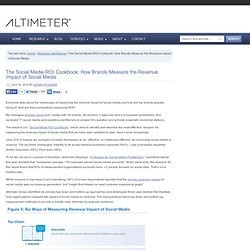
And are they successfully measuring ROI? My colleague Andrew Jones and I spoke with 16 brands, 38 vendors, 3 agencies and 4 ecosystem contributors, and surveyed 71 social media and analytics practitioners to answer this question and provide pragmatic recommendations. The result is our “Social Media ROI Cookbook,” which aims to identify and describe the most effective “recipes” for measuring the revenue impact of social media that we have seen adopted to date. Here’s what we learned: Only 30% of brands we surveyed consider themselves to be “effective” or “extremely effective” at connecting social media to revenue.
To be fair, we are in a period of transition: Jeremiah Owyang’s “A Strategy for Social Media Proliferation,” published earlier this year, showed that “companies average 178 corporate-owned social media accounts.” Where’s it all going? Related Posts. Measure ROI with Google Analytics. First off, I want to preface this post with the fact that social media shouldn’t be done only with the goal of making direct conversions.
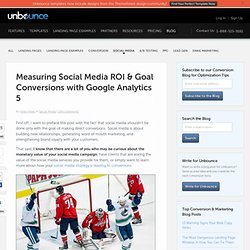
Social media is about building new relationships, generating word of mouth marketing, and strengthening brand loyalty with your customers. That said, I know that there are a lot of you who may be curious about the monetary value of your social media campaign, have clients that are asking the value of the social media services you provide for them, or simply want to learn more about how your social media strategy is leading to conversions.
You’ll be celebrating your social media goal conversions too! Image Source(editor’s note: sly usage of a Vancouver Canucks photo) The following are the steps you must implement to be able to see the return on investment and goal conversions for your social media campaign. Track goal conversions for your website in Google Analytics, a plus regardless of whether you care about social media conversions or not. 1. 2. 3. Social Media Measurement. Hot on the heels of last week’s Altimeter Open Research Report on Converged Media, today, analyst Susan Etlinger, Researcher Andrew Jones, (I served as editor) have published a report answering the absolute top asked question in the social space: “How do companies measure ROI of social?” In this definitive report, Altimeter found that there are half a dozen methods being deployed, each with flaws and strengths.
It’s key that the business knows which method to deploy, when, and then line up the right process, teams, software, and partners to help. Despite a thorough look into leading case samples and speaking with dozens of members of the ecosystem, we found there is no single solution that is fool proof. In this Open Research report, you will find: A through set of industry findings with 16 brands, 38 vendors, 3 agencies and 4 ecosystem contributors, and surveyed 71 social media and analytics practitioners. Key Finding: There is no “one-size-fits-all” approach.
Take Action Now. 5 Simple Steps to Measure Social Media ROI.